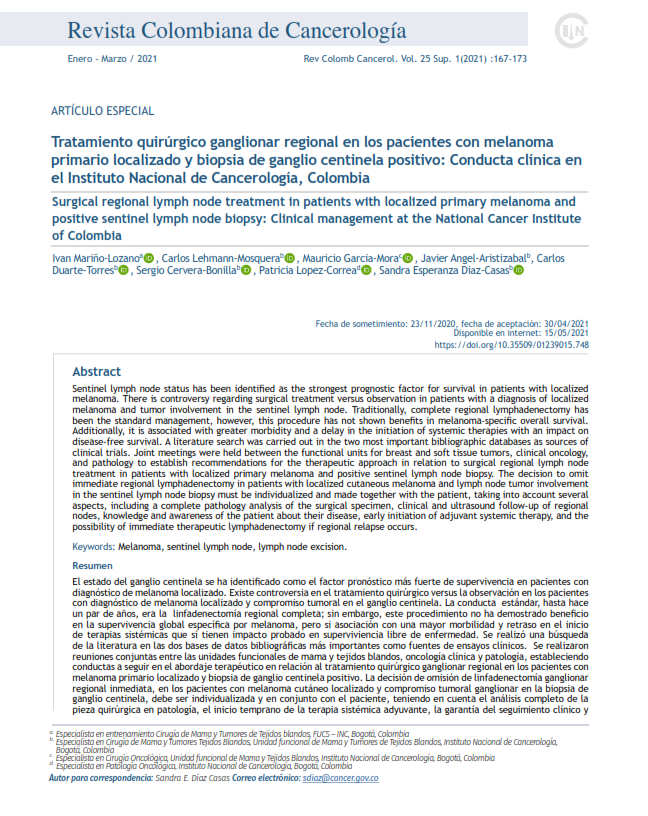Surgical regional lymph node treatment in patients with localized primary melanoma and positive sentinel lymph node biopsy: Clinical management at the National Cancer Institute of Colombia
DOI:
https://doi.org/10.35509/01239015.748Keywords:
Melanoma, sentinel lymph node, lymph node excisionAbstract
Sentinel lymph node status has been identified as the strongest prognostic factor for survival in patients with localized melanoma. There is controversy regarding surgical treatment versus observation in patients with a diagnosis of localized melanoma and tumor involvement in the sentinel lymph node. Traditionally, complete regional lymphadenectomy has been the standard management, however, this procedure has not shown benefits in melanoma-specific overall survival. Additionally, it is associated with greater morbidity and a delay in the initiation of systemic therapies with an impact on disease-free survival. A literature search was carried out in the two most important bibliographic databases as sources of clinical trials. Joint meetings were held between the functional units for breast and soft tissue tumors, clinical oncology, and pathology to establish recommendations for the therapeutic approach in relation to surgical regional lymph node treatment in patients with localized primary melanoma and positive sentinel lymph node biopsy. The decision to omit immediate regional lymphadenectomy in patients with localized cutaneous melanoma and lymph node tumor involvement in the sentinel lymph node biopsy must be individualized and made together with the patient, taking into account several aspects, including a complete pathology analysis of the surgical specimen, clinical and ultrasound follow-up of regional nodes, knowledge and awareness of the patient about their disease, early initiation of adjuvant systemic therapy, and the possibility of immediate therapeutic lymphadenectomy if regional relapse occurs.
References
[Internet] Gco.iarc.fr. 2021. [cited 10 January 2021]. Available from: <https://gco.iarc.fr/today/data/factsheets/cancers/16Melanoma-of-skin-fact-sheet.pdf>
Pozzobon F, Acosta Á, Castillo J. Cáncer de piel en Colombia: cifras del Instituto Nacional de Cancerología. Revista de la Asociación Colombiana de Dermatología y Cirugía Dermatológica. 2018;26(1):12-17.
Angeles C, Wong S. Management of Regional Nodal Melanoma. Surgical Oncology Clinics of North America. 2020;29(3):415431. https://doi.org/10.1016/j.soc.2020.02.007
Landry C, McMasters K, Scoggins C. The evolution of the management of regional lymph nodes in melanoma. Journal of Surgical Oncology. 2007;96(4):316-321. https://doi.org/10.1002/jso.20867
Cascinelli N, Morabito A, Santinami M, MacKie R, Belli F. Immediate or delayed dissection of regional nodes in patients with melanoma of the trunk: a randomised trial. The Lancet. 1998;351(9105):793-796. https://doi.org/10.1016/s01406736(97)08260-3
Balch C, Soong S, Bartolucci A, Urist M, Karakousis C, Smith T et al. Efficacy of an Elective Regional Lymph Node Dissection of 1 to 4 mm Thick Melanomas for Patients 60 Years of Age and Younger. Annals of Surgery. 1996;224(3):255-266. https://doi.org/10.1097/00000658-199609000-00002
Thompson J, McCarthy W, Bosch C, O??Brien C, Quinn M, Paramaesvaran S et al. Sentinel lymph node status as an indicator of the presence of metastatic melanoma in regional lymph nodes. Melanoma Research. 1995;5(4):255-260. https://doi.org/10.1097/00008390-199508000-00008
Morton D, Thompson J, Essner R, Elashoff R, Stern S, Nieweg O et al. Validation of the Accuracy of Intraoperative Lymphatic Mapping and Sentinel Lymphadenectomy for Early-Stage Melanoma. Annals of Surgery. 1999;230(4):453. https://doi.org/10.1097/00000658-199910000-00001
Leiter U, Stadler R, Mauch C, Hohenberger W, Brockmeyer N, Berking C et al. Complete lymph node dissection versus no dissection in patients with sentinel lymph node biopsy positive melanoma (DeCOG-SLT): a multicentre, randomised, phase 3 trial. The Lancet Oncology. 2016;17(6):757-767. https://doi.org/10.1016/S1470-2045(16)00141-8
Leiter U, Stadler R, Mauch C, Hohenberger W, Brockmeyer N, Berking C et al. Final Analysis of DeCOG-SLT Trial: No Survival Benefit for Complete Lymph Node Dissection in Patients With Melanoma With Positive Sentinel Node. Journal of Clinical Oncology. 2019;37(32):3000-3008. https://doi.org/10.1200/JCO.18.02306
Faries M, Thompson J, Cochran A, Andtbacka R, Mozzillo N, Zager J et al. Completion Dissection or Observation for Sentinel-Node Metastasis in Melanoma. New England Journal of Medicine. 2017;376(23):2211-2222. https://doi.org/10.1056/NEJMoa1613210
Long G, Hauschild A, Santinami M, Atkinson V, Mandalà M, Chiarion-Sileni V et al. Adjuvant Dabrafenib plus Trametinib in Stage IIIBRAF-Mutated Melanoma. New England Journal of Medicine. 2017;377(19):1813-1823. https://doi.org/10.1056/NEJMoa1708539
Weber J, Mandala M, Del Vecchio M, Gogas H, Arance A, Cowey C et al. Adjuvant Nivolumab versus Ipilimumab in Resected Stage III or IV Melanoma. New England Journal of Medicine. 2017;377(19):1824-1835. https://doi.org/10.1056/NEJMoa1709030
Eggermont A, Blank C, Mandala M, Long G, Atkinson V, Dalle S et al. Adjuvant Pembrolizumab versus Placebo
in Resected Stage III Melanoma. New England Journal of Medicine. 2018;378(19):1789-1801. https://doi.org/10.1056/NEJMoa1802357
Morton D, Thompson J, Cochran A, Mozzillo N, Elashoff R, Essner R et al. Sentinel-Node Biopsy or Nodal Observation in Melanoma. New England Journal of Medicine. 2006;355(13):1307-1317. https://doi.org/10.1056/NEJMoa060992
Morton D, Thompson J, Cochran A, Mozzillo N, Nieweg O, Roses D et al. Final Trial Report of Sentinel-Node Biopsy versus Nodal Observation in Melanoma. New England Journal of Medicine. 2014;370(7):599-609. https://doi.org/10.1056/NEJMoa1310460
Thomas J. Concerns relating to the conduct and statistical analysis of the Multicenter Selective Lymphadenectomy Trial (MSLT-1) in patients with melanoma. Journal of Plastic, Reconstructive & Aesthetic Surgery. 2009;62(4):442-446. https://doi.org/ 10.1016/j.bjps.2009.01.027
Altstein L, Li G. Latent Subgroup Analysis of a Randomized Clinical Trial through a Semiparametric Accelerated Failure Time Mixture Model. Biometrics. 2013;69(1):52-61. https://doi.org/10.1111/j.1541-0420.2012.01818.x
Habashi R, Francescutti V. Nonsurgical Management of Lymph Node Basins in Melanoma. Surgical Clinics of North America. 2020;100(1):91-107. https://doi.org/ 10.1016/j.suc.2019.09.008
How to Cite
Downloads

Downloads
Published
Issue
Section
License
Todos los derechos reservados.




